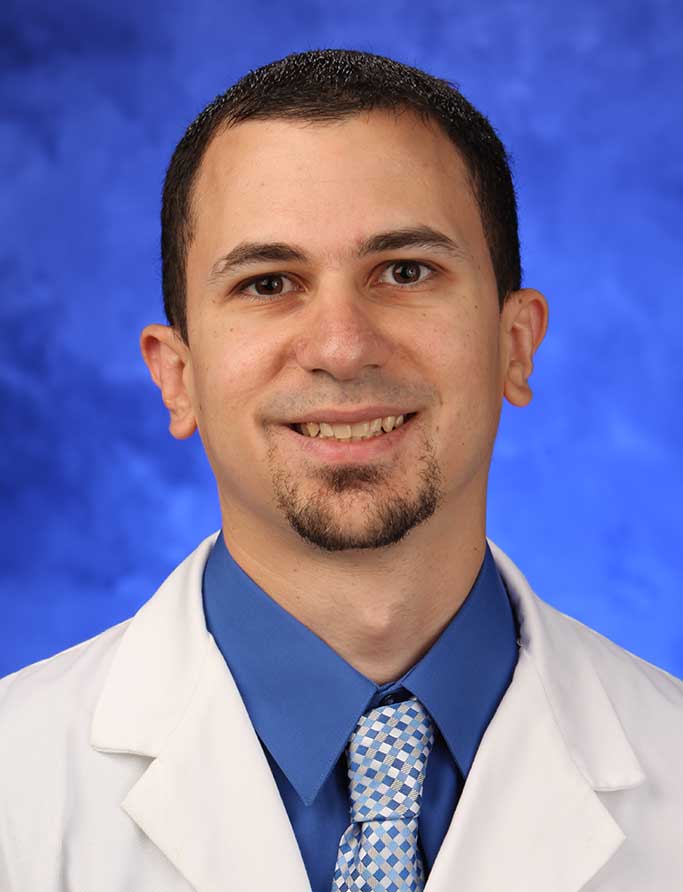Jump to topic
Search
Program Details
The Anesthesia Critical Care Fellowship endeavors to train fellows in the art and science of providing excellent, safe and compassionate clinical care to critical care patients and their families, and to foster the development of leaders in clinical and academic critical care anesthesiology.
Each fellow will rotate through all of the hospital’s intensive care units, including the surgical anesthesia ICU, which is the home base; the trauma unit; neuroscience ICU; medical ICU; and cardiothoracic ICU. Elective time in a vast array of disciplines such as infectious disease, nutrition and nephrology is available. The fellow will also undergo training in critical care ultrasound and a radiology educational block.
The program offers three weeks of vacation and one week of CME time (meetings, etc.); additional time for presenting posters or talks may be granted on a case-by-case basis.
Other resources available to fellows include:
- Fellows’ office space
- Electronic medical record system, including anesthesia records
- Online university library with electronic journals and texts
- Bronchoscopy, videolaryngoscopy, ultrasound in the ICU
- Physical university anesthesia library with comprehensive pediatric text collection
- Clinical Simulation Center
Learn More about the Fellowship
Eligibility
Candidates must be:
- U.S. citizens, permanent residents or J-1 visa holders (no additional visa types are sponsored)
- Board-eligible or board-certified in anesthesiology
- Eligible for a Pennsylvania medical training license
All applicants must be graduates of an ACGME-accredited anesthesiology residency prior to beginning the fellowship.
All applications must be submitted through SF Match.
Required Supporting Documents
In addition to the SF Match application, the following documents should be submitted via email to rsant@pennstatehealth.psu.edu:
- Curriculum vitae
- ECFMG certificate (if applicable)
- ISTE scores
- ABA basic exam result
Interview Process
Interviews will be conducted remotely. All fellowship applications must be submitted through SF Match. and applicants will receive further communication via the SF Match system.
Important Dates
- Feb. 10, 2025: Application deadline
- May 13, 2025: Rank list deadline
- May 27, 2025: Match results released
Virtual Tour
Penn State Health
Penn State Health is an integrated academic health system serving patients and communities across 15 counties in central Pennsylvania. It employs more than 20,900 people systemwide.
The system includes Penn State Health Milton S. Hershey Medical Center, Penn State Health Children’s Hospital and Penn State Cancer Institute based in Hershey, Pa.; Penn State Health Hampden Medical Center in Enola, Pa.; Penn State Health Holy Spirit Medical Center in Camp Hill, Pa.; Penn State Health Lancaster Medical Center in Lancaster, Pa.; Penn State Health St. Joseph Medical Center in Reading, Pa.; Pennsylvania Psychiatric Institute, a specialty provider of inpatient and outpatient behavioral health services, in Harrisburg, Pa.; and 2,417 physicians and direct care providers at 225 outpatient practices. Additionally, the system jointly operates various healthcare providers, including Penn State Health Rehabilitation Hospital, Hershey Outpatient Surgery Center and Hershey Endoscopy Center.
In 2017, Penn State Health partnered with Highmark Health to facilitate creation of a value-based, community care network in the region.
Penn State Health shares an integrated strategic plan and operations with Penn State College of Medicine, the University’s medical school. With campuses in State College and Hershey, Pa., the College of Medicine boasts a portfolio of more than $150 million in funded research and more than 1,700 students and trainees in medicine, nursing, other health professions and biomedical research.
Learn more about Penn State Health

Penn State Health Children’s Hospital (left), Penn State Health Milton S. Hershey Medical Center (center) and Penn State Cancer Institute (right)
Penn State Health Milton S. Hershey Medical Center
500 University Dr., Hershey, Pa., 17033 (Derry Township, Dauphin County)
- The health system’s 611-bed flagship teaching and research hospital
- The only medical facility in Pennsylvania accredited as both an adult and a pediatric Level I (highest-level) trauma center
- Dedicated surgical, neuroscience, cardiovascular, trauma and medical intensive care units
- Accredited Life Lion critical-care transport providing more than 1,100 helicopter and approximately 750 ground ambulance transports per year
- More than 1,300 faculty members and more than 650 residents and fellows
- Approximately 29,000 admissions, 73,000 emergency department visits, 1.1 million outpatient visits and 33,000 surgical procedures annually
- Designated as a Magnet hospital since 2007
Learn more about Milton S. Hershey Medical Center
Penn State Health Children’s Hospital
600 University Dr., Hershey, Pa. 17033 (Derry Township, Dauphin County)
- An eight-story, 263,000-square-foot-facility built in 2013 and expanded in 2020
- 160 licensed pediatric beds, 26-bed pediatric intensive care unit and a 56-bed neonatal intensive care unit
- Level IV (highest-level) neonatal intensive care unit
- Level I quaternary (highest-level) pediatric intensive care unit
- Level I (highest-level) pediatric trauma center designation
- Intermediate care unit
- Dedicated pediatric operating rooms
- More than 150,000 pediatric outpatient visits, 20,000 pediatric emergency room visits, and approximately 5,000 pediatric patient discharges annually
Welcome to Hershey
More About Hershey
Interested in learning more about living and working in Hershey, Pa.? See details here:
Wellness, including emotional, spiritual, social and physical health, is a crucial component to training and to becoming a professional, compassionate and resilient physician. Self-care is a skill which must be continually practiced and reinforced. Penn State College of Medicine and Penn State Health are committed to addressing wellness among residents and fellows, with multiple resources readily available.
Institutional resources
- Visit BeWell – a health program designed to support Penn State Health employees
- See Penn State College of Medicine wellness resources here
- Employee Health Care Concierge and Case Management Service
- Partners in Medicine
Moving to a new city with your family does not have to be stressful. Residency programs have assisted many significant others with finding employment. There is also a GME-Wide Partners in Medicine (PIM) group that offers networking opportunities as well as various social and community oriented activities. - The Doctors Kienle Center for Humanistic Medicine
- Active and easily accessed Office of Professional Mental Health
Graduate medical education resources
Institutional Resources
Penn State Health and Penn State College of Medicine celebrate, embrace and support the diversity of all patients, faculty, staff, students and trainees.
Office for Diversity, Equity and Inclusion
In keeping with this, Penn State Health has an active Office for Diversity, Equity and Inclusion with various programs, networks and resource groups, including:
- Talks and lectures on diversity, equity and inclusion through the Inclusion Academy
- Regular events on topics such as eradicating racism and creating a culture of inclusiveness
- Many Business Employee Resource Groups (BERGs), including:
- Disability Business Employee Resource Group
- Interfaith Business Employee Resource Group
- LGBTQ+ Business Employee Resource Group
- Military and Veterans Business Employee Resource Group
- Multicultural Business Employee Resource Group
- NextGen Business Employee Resource Group
- Black Physician Professional Staff Association – Resource Group
- Hispanic Professional Association
- Asian Physician and Professional Staff Association
- International Workforce Inclusion
- Inclusion Academy
Learn more about the Penn State Health Office for Diversity, Equity and Inclusion
Learn more about the College of Medicine’s Office for Diversity, Equity and Belonging
Office for Culturally Responsive Health Care Education
The vision at Penn State College of Medicine and Penn State Health is to equip learners with the knowledge, skills and attitudes they will need to provide culturally excellent health care and research for an increasingly diverse U.S. population. The Office for Culturally Responsive Health Care Education was formed to help meet that goal.
Learn more about the Office for Culturally Responsive Health Care Education
Office for a Respectful Learning Environment
In addition, the institution does not tolerate discrimination, biases, microaggression, harassment or learner mistreatment of any kind, and any concerns are immediately addressed by the Office for a Respectful Learning Environment.
Learn more about the Office for a Respectful Learning Environment
Network of Under-represented Residents and Fellows
The Network of Under-represented Residents and Fellows (NURF) is a group of diverse residents and fellows representing all specialties. NURF’s goal is to promote cultural diversity in the residency programs through community involvement, mentorship with diverse faculty, professional networking and support for the recruitment of diverse medical students into the residency programs.
NURF is sponsored by the Penn State College of Medicine Graduate Medical Education Office and the Penn State Health Office for Diversity, Equity and Inclusion.
Mailing Address
Penn State Anesthesiology and Perioperative Medicine
500 University Dr., H187
Hershey, PA 17033
General Contact Information
Phone: 800-206-7718
Fax: 717-531-0826
Curriculum Details
Fellows’ clinical experiences are based on monthly rotations in the surgical anesthesia/trauma intensive care unit, the neurosurgical critical care unit and the heart and vascular critical care unit.
The formal didactic curriculum includes bi-weekly fellow-level lectures, as well as departmental functions including Grand Rounds and Case Conferences and the Integrated Fellow’s Discussion Series.
Fellows engage in a scholarly project, for which they are granted non-clinical time.
Fellows participate as teachers as well as learners. They develop and deliver lectures to our residents, and often function as junior attendings, supervising residents in the ICUs.
Clinical rotations are done in 13 four-week blocks.
- Five blocks in the surgical anesthesia/trauma intensive care unit
- Anesthesia ICU patients from surgical subspecialties such as orthopedics, urology, gynecology, thoracic, transplant and surgical oncology, as well as obstetrics
- Trauma ICU patients from trauma and emergency general surgery as well as plastic surgery
- One block in the heart and vascular critical care unit
- Cardiology, vascular surgery, cardiac surgery and patients with ventricular assist devices or ECMO
- One block in the neurosurgical critical care unit
- Neurology, stroke and neurosurgery
- One block in the medical intensive care unit
- Wide array of pulmonary and medical problems as well as oncology
- One block in TTE/ultrasound/general radiology (time spent with radiology and cardiology)
- Focused imaging practice with subspecialty experts in addition to regular practice and instruction through the year
- Three blocks of electives
- Commonly in nutrition, nephrology and infectious disease, and an additional block of subspecialty ICU or research
- Fellow are expected to choose areas of interest or for improvement; a customized rotation can be approved by the program director
All fellows are required to complete a scholarly project. Topics can include bench research, clinical research or quality improvement/quality assurance. The fellow will be mentored by Penn State Health Milton S. Hershey Medical Center faculty, and required to complete a deliverable (abstract, poster, manuscript, etc.). Non-clinical time is provided to the resident, approximately one academic day per week.
Each fellow is required to develop and deliver two one-hour lectures to anesthesiology residents.
Fellows are given progressive responsibility in the ICUs, as dictated by formal and informal evaluations and assessments. Toward the latter half of the fellowship, most fellows will have the opportunity to supervise residents in the ICUs. This allows opportunities to develop supervisory and teaching skills, to facilitate the fellow’s transition from trainee to consultant attending.
Latest News from Anesthesiology






